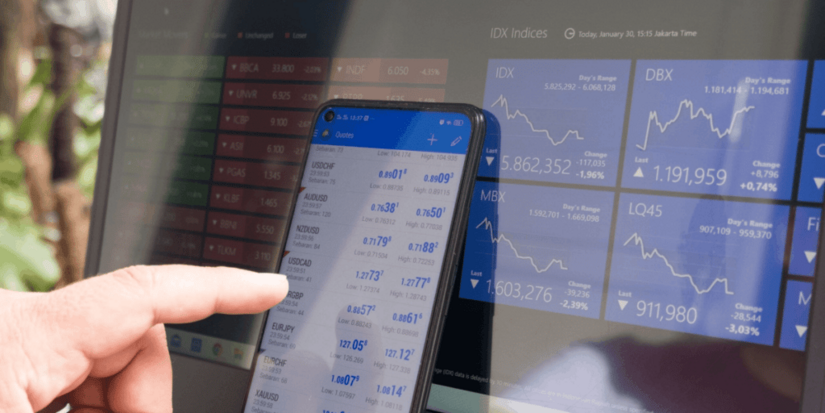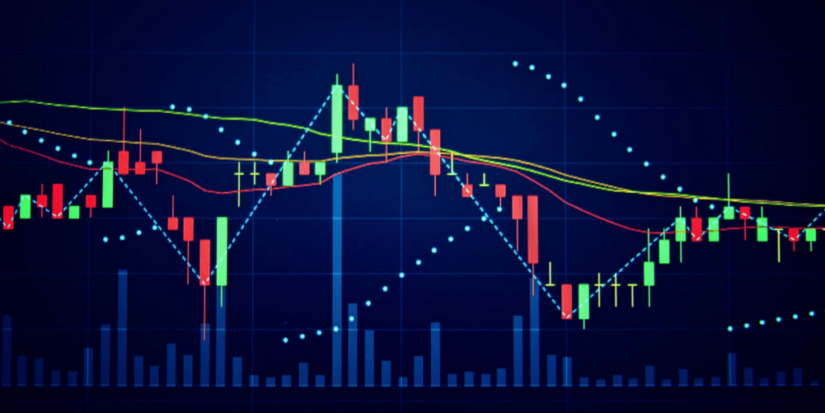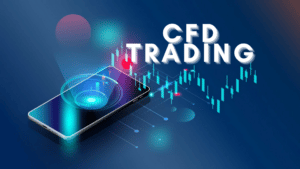What is CFD Trading – Is it profitable? – that will be the topic of today’s article.
If you are looking to invest as an expat or high-net-worth individual, which is what I specialize in, you can email me (advice@adamfayed.com) or WhatsApp (+44-7393-450-837).
Introduction
Today, we will be learning about CFD trading, which includes the definition and some important terms.
By the end of this post, you would have clearly understood the basics of CFD trading, and then, we will discuss whether or not they are profitable for you.
What is a CFD?

CFD is a financial instrument that allows an investor to speculate on the financial markets and make profits from them. CFD stands for Contract for Difference, and in the plural, it’s CFDs (Contracts for Difference).
The process of investing, i.e., buying or selling, and making money from CFDs is known as CFD trading.
With the help of CFDs, individuals can speculate on different types of assets such as shares, indices, commodities, and most popularly, forex.
How do they work?
This is similar to the trading activity of other financial instruments like forex.
When you are buying or selling CFDs, you will be speculating on the future price of an asset rather than owning the asset.
Trading with CFDs means that you are entering a financial contract. This contract will determine the difference in price between when the contract is opened and when it is closed.
Let us have a look at an example in simple words so that you can have a better understanding of how CFDs work.
So, let us assume that you opened a contract at point “A”, where the price is, let’s say, $1. Now, you speculated the price to increase by the time it reaches a certain point “B”.
Here, when your speculation is correct and the price does move up by the time it reaches point “B”, you will get a profit.
However, if it does not move according to your speculations and falls below the expected price, then you are subject to a loss.
Unlike the example mentioned above, you can anticipate the price direction in any movement, i.e., whether it will rise or fall.
Now that you understand, the CFD results in a profit when your forecast is right and results in a loss when your forecast goes wrong.
In simple words, you are just going to make a bet on an asset regarding the fall or rise in its price, without owning it.
While trading with CFDs, you are provided with two different prices, namely an ask (buy) price and a bid (sell) price.
The bid price is usually lower than the ask price, and the difference between these two prices is known as a spread. We’ll get to the spreads in a while.
When you speculate a rise in the price and buy the asset, then it is known as going long. When you expect a fall in the price and sell an asset, then it is known as going short.
Country-Specific Restrictions
Depending on the country of your residence, you may or may not be able to trade with CFDs.
This is because certain countries like the United States have banned CFD trading. Even though the U.S. bans trading CFDs, it allows non-residents to trade with them.
Even when some countries allow the trading of CFDs, there may be certain restrictions.
Cost

There are three types of charges involved with CFDs namely commissions, financing rates, and spread or difference between the bid and offer price.
Commissions
When you are trading with indices, commodities, etc., there won’t be any commission applicable to your trades.
Commissions usually apply to stock CFDs, where the commissions are charged on both the opening and closing trades.
In general, the commission charged for a stock CFD is based on the total value of the trade.
The actual commission you’ll need to pay depends on where the share has been listed. A minimum commission charge will be applicable on your CFD trades, which can be as follows.
UK Shares – 0.1% with a £10 minimum.
European shares – 0.1% with a €25 minimum
US Shares – 0.15% with a $25 minimum
For instance, let us say that you purchased 10,000 CFDs of a UK share worth £2, then the overall trade value is £20,000. Let us say that the commission applicable to that trade was 0.1%. Then the commission you would have to pay on that trade will be £20.
Spreads
Spread is nothing but the difference between the buy (ask) price and the sell (bid) price of a CFD instrument.
Spreads play a key role in CFD trading as it is how the derivatives are priced. CFD brokers, the market makes, and providers will quote the price as a spread.
It means that the price required to open a position, i.e., buy an asset, is a bit higher than the actual market price of that asset.
In the same way, closing a position, i.e., selling an asset, will be a bit lower than the actual market price of that asset.
In other parts of trading, spreads can be used for different meanings, but it is a difference between two price points.
You will hear a lot about the bid-offer spread when you are trading with CFDs, which may also be called the bid-ask spread.
The bid-ask spread evaluates the supply and demand of an asset that is being traded. When there isn’t much of a difference between the bid price and the offer price, then it is called a tight spread.
Where there is a lot of difference between the bid price and the offer price, then the spread is considered to be wide.
A tight spread determines that the buyer and seller agree on the value of an asset. When the spread is wide, it indicates that there is a difference in the opinions of the buyer and seller.
The bid-ask spread of a CFD can be influenced by multiple factors, which are listed below.
— First of all, liquidity plays a role in influencing the price of a spread. Liquidity means how easily an asset can be bought or sold. When the asset has higher liquidity, the spread is tight, and vice versa.
— Volume, which is the quantity of the asset being traded on a regular basis, also impacts the spread. Any asset with a higher trading volume will result in a tight spread and vice versa.
— Volatility, which refers to the pace of the market price movements in a given period, also influences a spread. When the markets are experiencing high volatility, the spread is wide, and when the markets have low volatility, the spread is narrow.
For instance, assume that the market price of an asset is $1,000, the buy price is $1,000.25 and the sell price is $999.75.
Now, the bid-ask spread of this asset would be 0.5 points. Here, you can see that when the trader buys the asset for a slightly higher price and sells the asset for a slightly lower price.
Financing rates
In simple terms, you will be paying financing rates as an interest payment for the amount leveraged.
Financing rates or financing charges are applicable to the overnight positions on the leverage.
It is calculated as the (overall trade value) multiplied by (Reserve Bank’s interbank overnight cash rate plus or minus 2 to 3%) divided by 365.
For long positions, the base rate plus 2 to 3 percent, and for short positions, the base rate minus 2 to 3 percent.
For example, when you are holding a position with a closing price of $10,000.
Now, the financing charge is determined by adding the provider premium (let’s say 2.5%) plus the RBA cash rate (let’s say 2%).
In this example, the financing charge would result in 4.5%.
Multiplying the trade value of $10,000 with the financing charge of 4.5%, you will get $450.
Now divide this amount by 365, and you will get $1.23, which is the amount to be paid per day for rolling over the contract to the next day.
For all the leveraged accounts, when you roll over the trade to another day (or more days), you will be paying a financing rate per day.
Most CFD contracts are leveraged, and therefore, you will be subject to financing charges.
However, if you trade only with cash, then there is no necessity for having a CFD account because you can just have a brokerage account and go for long-term trades.
Now that you know what a CFD is and how it works, let us have a look at some important terms. These terms are usually related to CFDs and you will come across them while trading with CFDs.
Leverage
As the name suggests, leverage allows you to get broad exposure to the market even when your deposit is small.
Why would some need leverage at all while trading? What’s the use? Are there any benefits?
If you are a beginner-level trader, there is no need to opt for a leveraged trade.
If you roll over your trade for another day or a couple of days, you may even have to pay financing rates, which we discussed above.
You might be thinking “Then what exactly is the use of a leveraged position at all?”
Well, it is specifically beneficial for experienced traders who want to have multiple trades at a single time.
Let me explain.
Imagine you are a trading expert with a capital of around $50,000 and started trading with CFDs.
Now, you wanted to trade with a certain share CFD, in which you want to buy 1,000 shares worth $50 each. Let’s assume that unless you purchase 1,000 shares, you won’t be able to trade with that specific CFD instrument.
Normally, you would be required to invest all the capital available at hand in order to participate in that trade.
That’s where leverage comes to the rescue, and you won’t be required to put up all the capital you have.
Let’s say that the margin is 10% for leverages, which means you would only be required to put up $5,000. You will still have $45,000 available with you, which can be used to trade with other CFDs while the previous trade is ongoing.
Not just that, but the risk involved with the CFDs can be minimized with the efficient use of CFDs.
Normally when you would have put up all the $50,000 capital, all of your funds are subject to risk.
Whereas, with the help of gearing or leverage, you would be able to minimize the risk involved.
This also helps you increase the diversification of your trades, especially when you use the remaining capital for other trades.
Sometimes you come across ratios such as 20:1 or 50:1, which might seem a bit confusing to beginners.
Don’t panic. These ratios are nothing but the total value of the transaction divided by the initial margin you need to put up.
For instance, when the initial margin requirement is 10%, then the ratio would be 10:1. This means, when the total transaction value is $10,000, you will only be required to put up $1,000 as capital.
With CFDs, the initial margin can be low as 1% or as high as 75%, and this depends on the specific instrument.
For volatile assets such as stocks, the initial margin requirement might be higher. For assets with less volatility in a short period such as forex, the initial margin requirement will be low.
This would also depend on the stop loss level of the trade, and the trades with a high point stop loss will come with a low margin requirement.
However, you should always remember the fact that leverage magnifies both the profits and losses that result in a trade.
Why? This is because the profits of losses would be based on the overall value of the trade rather than just the capital invested.
For example, imagine having a trade value of $10,000 with a margin of 10:1, which requires you to put up $1,000.
Now, assume that the price of the asset has increased to $10,050. Normally, you would assume that you will only get $5 as profits from your trade as you’ve only put in $1,000.
Well, that’s not the case here because you will be receiving the profits of $50 on your trade.
At the same time, imagine that the price went down to $9,500 in the same trade, then you will be at a loss of $500 rather than just a loss of $50.
Therefore, you must be extremely cautious while trading with leveraged accounts unless you are experienced.
Hedging with CFDs
Imagine that you had Apple shares in your portfolio and you thought they might experience a loss.
Now, going short on an Apple CFD trade would offset the potential loss in your stock portfolio because of the gains you made.
Stop Loss and Take Profit

Stop Loss Order
A stop loss order is a type of closing order that allows a trader to indicate a level of risk, at which the asset would be sold automatically.
This is a sort of risk management feature offered by the provider so that the trader won’t experience too much of a loss. Let us have a look at an example for you to have a better understanding.
Imagine you went long for an order with $1,000 in a share CFD with an expectation of it increasing in price. Now, imagine that the price instead went down to $990 instead of what you speculated.
This would mean that you have to deal with loss, and here’s where the stop loss can be beneficial.
You can place the stop loss level at something like $998 so that the order will be automatically executed at $998.
Hence, instead of dealing with a loss of $10, you will only have to deal with a loss of $2.
Even though a stop loss is meant to help the trader minimize the risk involved with the trade, it doesn’t offer 100% protection.
At certain times, the volatility becomes so high for certain assets that the price point from one level jumps to another level.
This happens without stopping at the stop loss level. This may result in a situation where the price might stop at a non-profitable price point.
Therefore, you should remember that the stop-loss order may be good but it may not always work in your favor.
Take Profit
The stop-loss order executes the trade before you experience losses, whereas the take-profit order works in the opposite way.
This order executes the trade upon reaching a certain level of profit. Didn’t get it properly? Let us have a look at an example for you to have a better understanding.
Imagine you went long for an order with $1,000 in a share CFD with an expectation of it increasing in its price. Now, assume that the price point did reach a level of $1,008 and after that, it went straight to $998.
This would result in losses, which can be avoided with the take profit order. If the take profit level was kept at $1,008, the trade would automatically be executed at that level with the gains of $8.
However, the trader would have to miss out on the additional profits, if any occur beyond the take profit level.
Now, let us have a look at some of the advantages as well as disadvantages of trading with CFDs. Let us begin by talking about the advantages of trading with CFDs.
Advantages
To begin with, CFDs allow you to access a wide range of international markets that include but are not limited to:
— Stocks
— ETFs
— Forex
— Cryptocurrencies
— Commodities
All this can be done with the ease of trading from a single platform, which is quite impressive.
CFDs act as per the actions that take place in the underlying markets. This allows you to have liquidity in the underlying market along with the liquidity offered by the CFD provider.
With the help of leveraged trading, you will not have to worry about investing a hefty sum of money to get more exposure.
Even with a small initial margin, you will be able to get huge profits, only when you do it correctly.
There are certain tax benefits when you are trading with CFDs, such as deductible interest repayments.
CFD brokers tend to be cost-efficient compared to full-service broker offering shares.
In the UK, there is no stamp duty for trading with share CFDs as you will not be purchasing the underlying security.
Most CFD brokers charge as low as £10 for trades ranging around £5,000, and not only that but you may also be charged as low as 0.01% for higher trades.
The process of trading with CFDs may not be as hard as one might think because one share would usually mean one CFD.
Along with that, trading activity such as going short or going long is easy to understand, even for beginners.
Some CFD providers allow trading with CFDs even when the underlying market is closed for the day.
The ability to hedge with CFDs allows an individual to offset the securities that he or she has in their portfolio.
With the help of stop-loss and take-profit orders, one can be able to get involved in CFD trading without too much of a risk.
Disadvantages
When you are trading with CFDs, you will be paying spreads on both the opening and closing positions of your trade.
This would leave a trader without the ability to make money from smaller price movements.
Even when you are not trading to make profits from smaller price movements, the spreads might eat up your profits by a small amount to a significant amount.
You may be able to avoid fees, regulations, commissions, and higher capital requirements, yet spreads might be enough to reduce your profits.
Following spreads, one of the major issues related to CFDs is regulation in some countries.
The CFD industry cannot be said as a highly regulated industry, and this is a major concern. You may or may not get access to a reputable CFD broker who has been in the field for some time.
More than that, you may not be able to find a CFD broker that is regulated by financial authorities.
Therefore, it is wise to conduct research on the broker before opting to choose them for CFD trading.
Remember the thing about leveraged trading?
Not only does it magnify the profits received from the trading activity, but instead it does the same to the losses as well.
Therefore, traders should act with utmost caution before getting into leveraged trading. If you don’t want to get into leveraged trades, it is best to acquire investment services from a traditional broker.
Not just the losses that can happen from your CFD trades, but because of the low capital requirement, most people start overtrading.
Overnight positions come with financing rates, which may reduce a lot of your returns when held for longer timeframes.
CFDs have a requirement for collateral in situations where the market tends to move against the trader. In such situations, traders would generally have to put more capital into their accounts or have to close their position, generally at a loss.
Usually, trading with CFDs comes with a higher risk compared to trading with mainstream assets such as shares.
Unlike buying shares, trading with CFDs does not offer you any kind of rights as a shareholder as you are not purchasing the underlying asset.
There is no availability for you to transfer your position to another broker as you don’t own the underlying securities.
Those who open a short position will need to pay the full dividend value if the CFDs are held over the record date.
Order types like stop-loss and take-profit allow an individual to stay wary before getting into too much risk. But they too have their downsides as we have discussed earlier while discussing them.
CFD trading requires a trader to actively manage their trading activity.
Is it profitable?

CFD trading, if not done properly, will mostly result in a scenario where you have to say goodbye to your hard-earned money.
I think that CFDs, or any other high-risk investments, are suitable for people with higher risk tolerance.
By people who have a higher risk tolerance, I mean the people who are young with a substantial amount of money.
Even if you have the right amount of risk tolerance, you will lose your money with CFDs if you don’t do it properly.
Why am I negative? Well, according to my extensive research on the internet, I have found out that 70% to 80% of retail investors lose their money with CFDs.
This suggests the complexity of making money with CFDs and makes it clear that only a few people make money from them.
High-risk investments, such as CFDs, should only be up to a certain limit of your portfolio.
The whole purpose of investing money is to make money from it and not to make a bet on whether or not you can make money.
I think that it is better to stick with long-term investments such as stocks, bonds, ETFs, etc., which would prove to be beneficial for you in the longer run.
Such conservative investment assets not only help you plan for your future but also tend to provide profits rather than losses.
Bottom Line
CFDs do have certain benefits, but you must pay attention to the fact that most people lose their money in CFD trading.
Being cautious about all the downsides that I’ve mentioned and limiting the capital for CFDs in your portfolio may help you get profits.
However, getting profits or losses depends on your trading activity and one cannot be sure of what the situation might be. Remember that you are only speculating the price movement, which may or may not happen within the selected timeframe.
Unless you have a significant amount of wealth and be prepared to handle the risk involved, I strongly suggest you stay away from CFDs.
Most people want to earn profits from their hard-earned money when they are investing it.
Whether it is for retirement or attaining financial freedom or securing your life from financial problems.
In such situations, you must be prepared to invest for the long term, which is for at least a couple of years.
If want to access wealth management services or investment services in the longer run, you can benefit from the financial services I offer.
I always try to preserve my clients’ wealth or help them make money in a less risky environment.
This will allow them to secure their future without having to worry about whether or not they make profits from their hard-earned money.
If you are someone looking for the services that I’ve mentioned above, then feel free to contact me to know whether or not you can benefit from what I offer.
I strongly hope that the information about CFDs in this article was helpful for you in knowing about the important information about CFD trading.
Pained by financial indecision? Want to invest with Adam?

Adam is an internationally recognised author on financial matters with over 830million answer views on Quora, a widely sold book on Amazon, and a contributor on Forbes.



